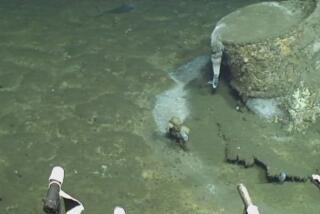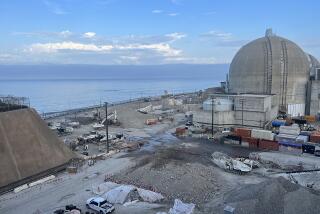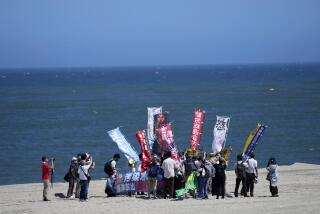A Hot-Button Issue in the North
- Share via
OSLO — They’re still sitting there, baking under the 24-hour-a-day Arctic summer sun, freezing under the icy crusts of winter, rusting in the sea breeze, just as they have for the past 35 years: 32 cracked and corroded casks of nuclear submarine fuel.
Each of them is believed to contain about as much radiation as the much-protested September 1995 French nuclear test at Mururoa atoll in the South Pacific.
“The difference is that the French test was 500 meters [1,640 feet] underground,” said Thomas Nilsen, a nuclear researcher with the Bellona Foundation, a Norwegian environmental group. “This is out in the open air. There isn’t even a fence around it.”
But the nuclear storage casks, located in northwest Russia near the Norwegian border, won’t be moved any time soon because no one can agree on how or where to move them safely.
Last year in Bergen, Norway, William J. Perry, then U.S. secretary of Defense, and his Russian and Norwegian counterparts agreed to work together to try to solve the cask problem and to defuse the other nuclear accidents that appear to be waiting to happen in the region.
But despite pledges of millions of dollars, and ongoing agitation here in Norway--which fears for its economically vital fisheries--only a few steps have been taken since the Bergen pact was signed.
“There is still time,” said another Bellona nuclear researcher, Nils Boehmer. “Nothing will happen next week, but if you don’t do anything for 20 to 30 years, then certainly things will start to leak into the environment.”
Two Russian counties, Murmansk and Arkhangelsk, share the dark distinction of having more nuclear reactors--317, functioning and otherwise--than any other region on Earth, as well as much of the world’s ocean-dumped nuclear waste. The material’s proximity to Norway has made it a major political issue here.
The Bellona Foundation, which did much of the groundbreaking research on Soviet nuclear waste, is focusing its attention on a single pilot project--the cleanup of a 270-foot nuclear storage ship called the Lepse, anchored in Murmansk harbor. The project is supposed to demonstrate new nuclear-management technologies, as well as promote international cooperation in the post-Cold War era.
Aboard the 50-year-old vessel are 624 spent nuclear fuel assemblies, whose radiation content equals about half the amount released during the Chernobyl accident in Ukraine in 1986.
Much of the fuel was loaded aboard the Lepse in 1966, after an accident on a Soviet nuclear icebreaker. Workers had to use sledgehammers to jam the fuel into the Lepse’s too-small storage containers, the foundation said. This caused so much additional damage that a cement sarcophagus had to be poured over the Lepse’s hold in 1993. But even that is now unsafe, according to the foundation.
Experts agree that the Lepse cannot remain this way; the fuel on board will remain radioactive for 200,000 years. But how to remove it from the cement-encased hold?
So far, a French engineering company, Paris-based SGN, has developed a robotic system to extract the fuel and put it into safer containers on shore.
And in the United States, Nuclear Assurance Corp. is developing huge casks to hold such spent fuel safely for about 50 years. By that time, a permanent nuclear storage site is supposed to have been made ready. Opinions still diverge widely on where this site should be, however.
Meanwhile, there are lesser questions to be answered, about Russian import taxes on the French robotics, and about liability: Who will be responsible if something goes wrong while Russian crews are using the French hardware?
Participants hope that those legal questions will be resolved by this fall. Then, a mock-up of the Lepse can be built, and the French lifting device tested on it.
Sherri Goodman, U.S. deputy undersecretary of Defense for environmental security, says the American casks must be tested by Russian authorities before they can be used.
“We expect that to take place in 1998 and 1999,” she said.
The nuclear waste is ready and waiting, but even a symbolically important pilot project like the Lepse cannot be rushed, experts say. “They have to be really sure that nothing goes wrong,” Boehmer said. “Because if there is an accident . . . that could lead to a major contamination in Murmansk, a city with half a million people.”
More to Read
Sign up for Essential California
The most important California stories and recommendations in your inbox every morning.
You may occasionally receive promotional content from the Los Angeles Times.










